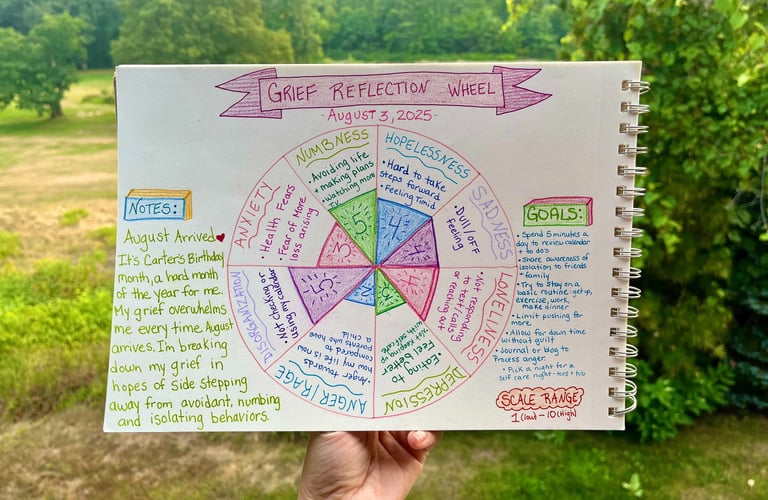Riding the August Rollercoaster: Honoring Grief with Awareness
Naming your feelings doesn't take away the pain but it can help you breathe through it. This post is about creating space to notice and care for whatever is showing up.
8/5/20253 min read


August has arrived again. It’s a bittersweet month for me, Carter’s birthday month. My Leo would be turning 17 this year. It’s hard to believe I would be the mother of a seventeen-year-old. I love reflecting on the day Carter was born and the amazing birthdays I was fortunate to share with him. With it though there’s also a heavy weight of sadness that he’s no longer here to grow with.
Each year around his birthday, I notice myself slipping into some of my less healthy grief habits. It’s not sudden, it creeps in slowly. My mood dulls, I seek numbness, and I begin to isolate. These shifts aren’t intentional, they just come. My body and mind remember that August is coming.
One thing I’ve learned on this grief journey is that awareness is everything. I can’t make changes or care for myself if I’m not aware of what’s happening beneath the surface. It took years for me to recognize these patterns in myself and even longer to want to do something about them. I’m incredibly proud of the hard changes I’ve made. Awareness, followed by action, has been my greatest tool but getting there wasn’t easy.
Healing from grief isn’t something you just “do” or “finish.” Grief stays with you, it becomes part of your life. It’s like a rollercoaster: sometimes steady, sometimes soaring, and sometimes plummeting. As Carter’s 17th birthday approaches, I find myself on a downward ride again. The difference now? I notice it much sooner. It used to take me months. Now, it takes about a week to recognize the signs and start adjusting.
This time, when I felt the numbness and withdrawal creeping in, I said to myself, “Ah, there you are, grief.” Instead of letting it take over, I turned toward it. I pulled out a tool my grief coach introduced me to, a Grief Reflection Wheel.
Instead of avoiding my pain, I acknowledged it. I sat with my feelings, named them, and rated their intensity. I was honest with myself. I noticed signs of depression creeping in, emotional eating, letting my self-care slip. These are my red flags. I also couldn’t return texts or calls. I was withdrawing. I started numbing with TV and ignoring my calendar. Years ago, I wouldn’t have noticed or wouldn’t have wanted to. Now, I see it, name it, and try to respond with compassion.
Once I identify what’s happening, I can create small, supportive goals. For example, since I’ve been avoiding my calendar, my goal is simply to look at it for five minutes a day. I don’t need to do anything on the list, just look. Often, I’ll end up doing one small task, and that’s a win.
I also find that sharing with loved ones helps. Letting them know I’m sliding into isolation mode relieves some of the guilt and helps me feel seen and supported. They don’t need to fix it, but their awareness lightens my load.
For me, routine and movement are critical for mental health. When I’m low, I resist both, but deep down I know they help. So I aim to take a walk, feed myself nourishing food, and keep up with the essentials of self-care. I’ve learned through many hard lessons what happens when I don’t, which has become a bit of a motivator.
By acknowledging my emotions, noticing my behaviors, and setting small, manageable goals, I feel more in control of this grief rollercoaster. Feeling out of control is one of the hardest parts of grief, but tools like this help me stay grounded.
I’m still moving through this wave of grief, but now I have the self awareness and the self compassion to ride it out.